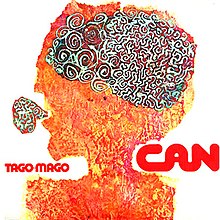Tago Mago
| Tago Mago | ||||
|---|---|---|---|---|
 |
||||
| Studio album by Can | ||||
| Released | February 1971 | |||
| Recorded | November 1970-February 1971 at Schloss Nörvenich, near Cologne, Germany | |||
| Genre | Krautrock, avant-funk, psychedelic rock, experimental rock | |||
| Length | 73:27 | |||
| Label | United Artists | |||
| Producer | Can | |||
| Can chronology | ||||
|
||||
| Alternative cover | ||||

40th anniversary edition
|
||||
| Professional ratings | |
|---|---|
| Aggregate scores | |
| Source | Rating |
| Metacritic | 99/100 |
| Review scores | |
| Source | Rating |
| AllMusic | |
| Pitchfork | 9.3/10 (2004) 10/10 (2011; 40th Anniversary Edition) |
| Stylus | B |
| Uncut | favorable |
Tago Mago is the third album by the German krautrock band Can, and was originally released as a double LP in 1971 by United Artists. It was the band's second studio album and the first to feature Damo Suzuki after their previous vocalist, Malcolm Mooney, quit the band in 1970 to return to the United States.
Tago Mago has been described as Can's magnum opus and their most extreme record in terms of sound and structure. The album has received much critical acclaim since its release and has been cited as an influence by various artists.
After Malcolm Mooney left Can in 1970 the remaining members were left without a vocalist. Bassist Holger Czukay happened to meet Kenji "Damo" Suzuki when the latter was busking outside a cafe in Munich. He introduced himself as a member of an experimental rock band and invited Suzuki to join them. That evening, Suzuki performed with the band at the "Blow Up club" and subsequently became a member of Can.
Tago Mago was recorded in 1971 by Czukay in Schloss Nörvenich, a castle near Cologne. The band was allowed to stay there for a year without paying any rent by the owner, an art collector named Mr. Vohwinkel. This was the first of Can's albums to be made from not only regularly recorded music, but combined "in-between-recordings", where Czukay secretly recorded the musicians jamming while waiting for various technical problems to be resolved. Czukay would edit these long, disorganized jams into structured songs. According to Czukay, the album was named after Isla de Tagomago, an island off the east coast of Ibiza. Recording was completed in three months.
It was originally released as a double LP in 1971 by United Artists. In September 2004, the album, along with the majority of Can's discography, was remastered and released as a hybrid SACD. The rerelease includes a booklet with commentary on the album by Bobby Gillespie of Primal Scream and David Stubbs, as well as previously unreleased photos of the band. In 2011, for the 40th anniversary of its release, the 2004 remaster was released again with an extra disc of previously unreleased 1972 live performances.
...
Wikipedia
